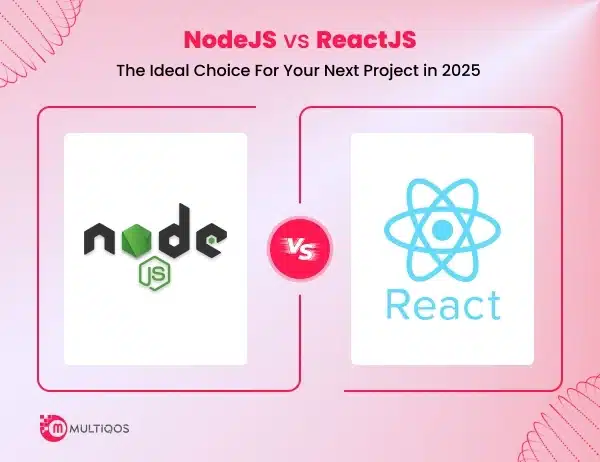NodeJS vs ReactJS: The Ideal Choice For Your Next Project in 2025

Table of Contents
- Introduction
- What is NodeJS?
- Features of Node.js
- Advantages of Node.js
- Disadvantages of Node.js
- What is ReactJS?
- Features of React.js
- Advantages of React.js
- Disadvantages of React.js
- NodeJS vs ReactJS - Comparison Table
- ReactJS vs NodeJS - In-Detail Comparison
- React vs Node - Use Cases
- Top Companies Using ReactJS vs NodeJS
- Why Choose MultiQoS For Your ReactJS and NodeJS Development?
- Conclusion
- FAQs
Summary:
NodeJS vs ReactJS are two powerful technologies widely used in web development today. NodeJS is a backend runtime environment, while ReactJS is a frontend JavaScript library for building user interfaces. Choosing between the two depends on the nature and needs of your project. In this blog, we’ll break down their features, advantages, disadvantages, and key differences to help you decide which technology aligns best with your business goals and development requirements.
Introduction
ReactJS vs NodeJS are two of the most prominent names in web and app development today. As businesses push for faster, scalable, and user-centric applications, selecting the right technology is crucial. In this blog, we will explore both technologies to help you align your tech stack with your project goals.
When comparing NodeJS vs ReactJS, it’s vital to know that these technologies cater to different layers of application development. NodeJS, a backend runtime built on Chrome’s V8 JavaScript engine, is celebrated for its ability to handle high-concurrency applications like APIs and real-time systems. In contrast, ReactJS, developed by Facebook, is a front-end library focused on building fast, responsive, and modular user interfaces.
Recent studies, including the Stack Overflow Developer Survey 2024, reveal that 40.8% of developers worldwide prefer NodeJS for backend tasks, while 39.5% favor ReactJS for front-end development. These numbers underscore the massive popularity and reliability of both technologies across diverse industries.
Understanding their roles, strengths, and limitations is key to making strategic decisions that impact your project’s performance, maintainability, and long-term scalability.
What is NodeJS?
NodeJS vs ReactJS comparisons often start by understanding each technology individually. NodeJS is an open-source, cross-platform JavaScript runtime environment designed for building scalable network applications. It allows developers to use JavaScript for backend development, breaking the traditional front-end-only limitation.
NodeJS, built on Chrome’s high-performance V8 engine, was introduced by Ryan Dahl in 2009. It is widely used to develop real-time applications, APIs, microservices, and even IoT systems. Unlike traditional server-side technologies, NodeJS operates on a non-blocking, event-driven architecture, which makes it exceptionally lightweight and efficient for handling multiple simultaneous connections.
Today, NodeJS powers some of the biggest platforms on the internet. According to a 2024 industry report, over 30 million websites worldwide are currently built using NodeJS. Its active community and regular updates keep it a relevant and future-proof choice for businesses of all sizes. Whether you’re building chat applications, e-commerce platforms, or real-time dashboards, NodeJS provides the flexibility and speed that modern projects demand.
Features of Node.js
Node JS vs React JS is a common debate among developers, but to truly appreciate NodeJS, understanding its core features is essential. NodeJS is built for speed, scalability, and efficiency, making it a favorite choice for backend development in modern web projects.
One standout feature of NodeJS is its asynchronous and event-driven architecture, allowing non-blocking operations that enhance performance significantly. It uses a single-threaded event loop, meaning it can handle thousands of simultaneous connections without creating new threads for each one. This design makes NodeJS incredibly efficient for real-time applications like chats, gaming servers, and live updates.
Another important feature is the NPM (Node Package Manager), the world’s largest ecosystem of open-source libraries, making development faster and more reliable. NodeJS also boasts cross-platform compatibility, enabling developers to create applications for Windows, Linux, and macOS with minimal adjustments.
Moreover, thanks to the use of the V8 JavaScript engine, NodeJS delivers exceptional execution speed, making it a great option for high-performance and data-intensive applications. With constant updates and active community support, NodeJS continues to evolve as one of the top choices for backend development.
Advantages of Node.js
When businesses evaluate NodeJS vs ReactJS, it’s important to recognize the distinct advantages NodeJS offers for backend development. Its unique architecture and thriving ecosystem have made it a favorite for building scalable and efficient applications.
One of the biggest advantages of NodeJS is its high scalability. Thanks to its event-driven, non-blocking I/O model, NodeJS can handle a vast number of simultaneous requests with minimal server resources. This is why it’s often used in real-time applications like online gaming, live chats, and streaming services.
Another major benefit is faster development cycles. Using JavaScript on both the client and server sides reduces the need for context switching, helping teams become more productive. Additionally, with access to over 1.3 million packages via NPM, developers can accelerate the development process and add robust features without building everything from scratch.
NodeJS also ensures better performance by executing code outside of a web browser. This allows for easier file system access, optimized network speed, and quick response times — key for businesses aiming for superior user experiences. Its active community, regular updates, and corporate support (like NodeJS Foundation and OpenJS Foundation) add to its reliability and growth prospects.
Disadvantages of Node.js
When businesses consider Node.js and React, it’s equally important to weigh the disadvantages of NodeJS to make an informed technology choice. No framework or runtime is perfect, and understanding the limitations helps in strategic planning.
One key limitation of NodeJS is its single-threaded nature, which makes it less effective for CPU-intensive operations like heavy computations or complex data processing. In such cases, NodeJS might experience performance bottlenecks because it cannot easily distribute workloads across multiple CPU cores without extra effort.
Another drawback is the immaturity of some NPM packages. While NPM boasts a massive library, not all modules are well-documented or well-maintained, posing risks of security vulnerabilities or unstable performance. A 2024 security report indicated that nearly 14% of NPM packages had unresolved security issues, emphasizing the need for careful dependency management.
Moreover, NodeJS’s asynchronous programming model can be challenging for new developers. Although it improves performance, managing callbacks and promises in complex applications can lead to callback hell or messy code structures without best practices in place.
By understanding these disadvantages, businesses can better plan their development strategies and mitigate potential risks when building with NodeJS.
What is ReactJS?
Node JS vs React JS is often discussed in the context of full-stack development, but to truly understand ReactJS, it’s crucial to explore its unique role in building user interfaces. ReactJS is a powerful, open-source JavaScript library developed by Facebook, designed specifically for creating dynamic and interactive web applications.
Launched in 2013, ReactJS introduced a revolutionary concept called the virtual DOM (Document Object Model), which enhances app performance by updating only parts of the page that change rather than reloading the entire UI. This makes React apps faster, smoother, and more efficient compared to traditional front-end frameworks.
ReactJS emphasizes a component-based architecture, allowing developers to break down complex UIs into smaller, reusable pieces. This not only speeds up development but also makes code easier to manage and debug. Additionally, React’s flexibility enables seamless integration with other libraries or frameworks like Redux for state management or even backend technologies like NodeJS.
React’s dominance is evident — according to a 2024 developer survey, nearly 47% of front-end developers prefer ReactJS, making it the most used front-end library globally. Whether you’re building a simple landing page or a massive enterprise application, ReactJS offers the scalability and performance modern web users expect.
Features of React.js
Node JS vs React is a popular comparison, but understanding React’s features highlights why it stands out as a leading front-end technology. ReactJS offers powerful tools and patterns that simplify building large-scale, high-performance web applications.
One of the most revolutionary features of ReactJS is its Virtual DOM. Instead of reloading the entire web page when data changes, React updates only the changed elements, improving speed and user experience dramatically. This optimization is key for creating fast and interactive applications.
Another major feature is component-based architecture, which encourages developers to break the UI into independent, reusable pieces. This modularity not only speeds up development but also makes code easier to maintain and test.
React also supports unidirectional data flow, meaning data flows in a single direction throughout the application. This simplifies debugging and improves the predictability of how data changes impact the UI. Additionally, React offers powerful developer tools like React Developer Tools for Chrome and Firefox, making real-time component inspection and state monitoring easier.
Finally, React’s JSX syntax — a blend of JavaScript and HTML — makes writing components intuitive and closer to the way the UI looks, reducing cognitive load during development. These features combined make ReactJS a powerhouse for front-end development.
Advantages of React.js
When evaluating Node vs React, understanding ReactJS’s advantages can help businesses and developers see why it remains a favorite choice for front-end development. React’s design philosophy emphasizes efficiency, flexibility, and scalability — key traits for modern web applications.
One of the top advantages of ReactJS is its performance optimization. Thanks to the Virtual DOM and efficient rendering techniques, React apps deliver faster load times and smoother user experiences. Studies show that React-based websites load up to 30% faster than those built with traditional JavaScript frameworks.
React’s component reusability significantly accelerates development. Developers can create a component once and reuse it across multiple parts of an application or even across projects. This leads to greater code consistency, lower maintenance costs, and quicker updates.
Another major advantage is strong community support. With millions of active developers, React boasts a massive collection of libraries, tools, and learning resources. This makes onboarding new developers easier and solving complex problems faster.
Moreover, React’s flexibility means it can easily integrate with various other technologies, including backend platforms like NodeJS or state management libraries like Redux. This versatility allows businesses to customize tech stacks tailored to their project needs without being locked into a rigid framework.
Disadvantages of React.js
In the ongoing React JS vs Node JS debate, it’s also important to consider the downsides of ReactJS. While React offers many benefits, it’s not without its challenges, especially for teams new to front-end development or large-scale applications.
One major drawback of ReactJS is the fast-paced evolution of its ecosystem. Frequent updates and new libraries often lead to confusion, especially for beginners. Developers sometimes struggle to keep up with best practices, making it harder to maintain codebases over time.
Another disadvantage is SEO challenges. Although React applications are highly dynamic, search engines sometimes have trouble indexing client-side rendered pages. Solutions like server-side rendering (using Next.js) exist, but they add complexity to the project.
React’s learning curve can also be steep for newcomers. Mastering concepts like JSX, component lifecycle, hooks, and state management takes time. Additionally, because React is a library (not a full-fledged framework), developers often need to integrate multiple third-party packages for routing, state management, and form handling, which can lead to inconsistent architectures.
Despite these disadvantages, many of these challenges can be managed with the right expertise and project planning, allowing businesses to fully capitalize on React’s strengths
NodeJS vs ReactJS – Comparison Table
The React vs Node JS comparison often leads to confusion because they serve very different purposes in application development. To make things clearer, here’s a side-by-side comparison table highlighting the major differences between NodeJS and ReactJS based on various factors.
| Factor | NodeJS | ReactJS |
| Type | Runtime Environment (Backend) | (Backend) JavaScript Library (Frontend) |
| Purpose | Server-side scripting, backend development | Building interactive user interfaces |
| Language Used | JavaScript | JavaScript (with JSX) |
| Learning Curve | Easy to moderate | Moderate to steep |
| Performance | High, especially for I/O operations | High, especially for dynamic UIs |
| Scalability | Highly scalable for real-time applications | Scalable through component-based architecture |
| Use Case Examples | APIs, streaming services, real-time apps | Single Page Applications (SPAs), dashboards |
| Community Support | Very strong | Extremely strong |
| Notable Companies | Netflix, LinkedIn, PayPal | Facebook, Instagram, Airbnb |
ReactJS vs NodeJS – In-Detail Comparison
React vs Node comparisons require a deep dive into their respective capabilities. To make an informed decision, businesses need to understand how both technologies perform across critical areas like popularity, learning curve, scalability for microservices, community backing, and performance impact.
Usage Statistics and Popularity
ReactJS and NodeJS continue to dominate the web development landscape. According to the 2024 Stack Overflow Developer Survey, 47% of developers prefer ReactJS for front-end development, while 42% rely on NodeJS for backend services. React’s dominance in building fast, interactive UIs and Node’s stronghold in server-side performance indicate how essential both technologies have become for modern app development.
These statistics also reflect the massive hiring demand for both skills. Companies that hire software developers often prioritize expertise in ReactJS for front end and NodeJS for backend, showing that full-stack development proficiency using both tools is increasingly valuable. Their popularity ensures a steady stream of updates, tooling improvements, and developer support worldwide.
Learning Curve
The learning curve is a major consideration when comparing ReactJS vs NodeJS. NodeJS is relatively straightforward for JavaScript developers because it uses the same core language principles but applies them to server-side operations. Developers familiar with asynchronous programming, event-driven models, and APIs can quickly become productive in NodeJS.
ReactJS, however, requires understanding new concepts such as JSX (a syntax extension combining JavaScript and HTML), component hierarchies, state management, and lifecycle methods. Although React’s modular structure ultimately enhances efficiency, the initial setup can feel overwhelming for beginners. Mastery requires investment in learning best practices around Hooks, context APIs, and performance optimizations.
Microservices
NodeJS is an excellent fit for building microservices-based architectures. Its lightweight runtime, asynchronous handling of requests, and fast execution make it ideal for creating independent, distributed services that communicate over APIs. Many large-scale companies like Netflix and PayPal use NodeJS microservices to scale operations without sacrificing performance.
While ReactJS does not directly build microservices, it integrates seamlessly with them. Applications built with ReactJS often consume APIs powered by NodeJS microservices. This separation of concerns — using NodeJS for backend services and ReactJS for front-end rendering — creates scalable, maintainable, and highly performant enterprise applications.
Community
Both NodeJS and ReactJS enjoy vast, active communities that continuously drive innovation. The NodeJS community has contributed to thousands of libraries, frameworks (such as Express.js and NestJS), and best practices for server-side development. Its association with major organizations like the OpenJS Foundation ensures ongoing improvements and security updates.
ReactJS’s community is equally vibrant, producing widely used libraries like Redux, React Router, and Material-UI. Whether you need to hire NodeJS developers or hire ReactJS developers, the massive ecosystem guarantees a large talent pool and a wealth of open-source tools. Continuous community contributions ensure that both technologies evolve rapidly to meet changing industry demands.
App Size & Performance
NodeJS is known for its exceptional backend performance, particularly in handling concurrent network requests without consuming significant memory. Its non-blocking, event-driven architecture allows real-time applications, like chat apps and streaming services, to run smoothly under heavy loads. This makes NodeJS ideal for businesses requiring fast and scalable backend systems.
ReactJS optimizes front-end performance through innovations like the Virtual DOM, lazy loading, and server-side rendering. By selectively updating components instead of refreshing entire pages, ReactJS apps achieve faster load times and smoother interactions. Combined, using NodeJS and ReactJS allows companies to build full-stack applications that are both lightning-fast and highly resilient.
React vs Node – Use Cases
React vs Node comparisons aren’t just theoretical — in real-world development, knowing when to use each technology is key. Choosing the right tool depends heavily on the nature of the project, scalability requirements, user interaction needs, and long-term maintenance goals.
NodeJS is the preferred choice for building real-time applications like messaging apps, online gaming platforms, and live streaming services. Its event-driven, non-blocking architecture makes it ideal for apps that require frequent server-client communication without delays. NodeJS also shines in building APIs, microservices-based applications, IoT solutions, and backend services for single-page applications.
ReactJS, on the other hand, excels in creating highly interactive user interfaces. If your project demands a smooth, fast, and dynamic front-end experience — such as social media platforms, e-commerce websites, dashboards, or SaaS applications — ReactJS is the right pick. Its component-based architecture allows developers to build scalable and maintainable frontends quickly.
Another key point to note is that ReactJS and NodeJS are often used together in full-stack development. For instance, an e-commerce platform might use ReactJS to power the user interface while leveraging NodeJS to manage the server-side operations, payment gateways, and database connections. When combined strategically, they offer an end-to-end solution for building modern web applications.
Top Companies Using ReactJS vs NodeJS
ReactJS vs NodeJS has become the backbone for many of the world’s most innovative and high-traffic applications. Top companies leverage these technologies to achieve scalability, fast performance, and seamless user experiences, depending on their project needs and architecture goals.
Many tech giants use NodeJS for server-side operations due to its speed and efficiency. For example, Netflix uses NodeJS to handle its massive global traffic and deliver content seamlessly to millions of users. LinkedIn transitioned from Ruby on Rails to NodeJS, resulting in a 20-fold increase in performance for its mobile app backend. PayPal also adopted NodeJS to build its user-facing content layer, achieving faster development cycles and improved user experience.
On the front-end side, ReactJS is the preferred choice for several globally recognized brands. Facebook originally built and continues to maintain React, making it a core technology for its web applications. Instagram, a Facebook product, uses ReactJS to ensure dynamic, fast, and scalable front-end features. Airbnb also built its entire front end using ReactJS, emphasizing modular, reusable components that enhance both developer productivity and customer experience.
By analyzing the tech stacks of these major companies, it’s clear that businesses looking to hire software developers skilled in NodeJS or ReactJS are investing in future-proof, scalable technologies trusted by industry leaders worldwide.
Why Choose MultiQoS For Your ReactJS and NodeJS Development?
Choosing between React vs Node JS is just the first step — collaborating with an experienced development partner like MultiQoS ensures your project is executed with precision and innovation. Our team specializes in building scalable, high-performing solutions using modern technologies like ReactJS and NodeJS to meet diverse business needs.
If you are looking for industry-vetted NodeJS developers, MultiQoS offers backend experts skilled in crafting fast, efficient, and scalable server-side applications. From building real-time systems to custom APIs and enterprise solutions, our NodeJS professionals deliver high-quality results aligned with your business goals through agile, collaborative workflows.
On the front-end side, businesses seeking professional ReactJS developers will benefit from our expertise in creating dynamic, user-friendly, and responsive interfaces. We leverage React’s component-based architecture to build applications that are not only aesthetically impressive but also highly maintainable, ensuring long-term performance and user satisfaction.
Partnering with MultiQoS means choosing a team dedicated to delivering excellence, innovative solutions, and complete transparency throughout your development journey. We are committed to helping you stay competitive by building robust software products tailored to the ever-evolving digital market.
Conclusion
React vs Node comparisons will continue to influence how businesses build modern, scalable applications. Understanding the strengths of both technologies is key to making the right development decisions. NodeJS powers efficient, real-time backend services, while ReactJS delivers dynamic, user-friendly frontends. Choosing the right one — or using them together — depends on your project’s requirements, long-term scalability, and the expertise available within your team.
Ultimately, NodeJS vs ReactJS is not about which is better universally, but which is better for your specific use case. Many successful companies today combine both technologies to create robust, high-performing full-stack applications. Whether you are building a startup MVP or an enterprise-level solution, getting in touch with a leading software development company can give your project the competitive edge needed in today’s digital-first market.
Frequently Asked Questions
NodeJS and ReactJS serve different purposes, so one isn’t inherently better than the other. NodeJS is ideal for backend development, especially for real-time applications, while ReactJS is perfect for building fast, dynamic user interfaces. Your choice should depend on your project’s specific requirements.
Yes, absolutely! In fact, many full-stack applications use ReactJS for the front end and NodeJS for the back end. This combination offers a seamless development process using JavaScript across both the client and server sides, improving performance and developer efficiency.
Leading companies like Netflix, PayPal, LinkedIn, and Uber use NodeJS to power their server-side operations. Brands like Facebook, Instagram, Airbnb, and Shopify rely on ReactJS for creating fast and interactive user experiences. Both technologies are trusted by some of the world’s largest platforms.
It depends on the development phase you are in. If you are setting up the server-side architecture and APIs, you should hire NodeJS developers first. If your focus is on building the front-end user interface, hiring ReactJS developers would be the priority. Ideally, both roles are essential for a complete solution.
Yes, NodeJS is excellent for building scalable applications. Its event-driven, non-blocking architecture allows it to handle thousands of concurrent connections efficiently, making it a great choice for real-time apps, streaming services, and enterprise-grade backend solutions.
Get In Touch





